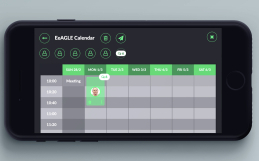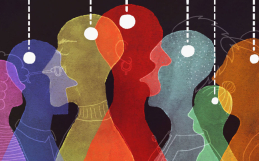Born in Need: Bringing Online Leadership Development to the Next Level
The New “Blended”: Integrating Individual and Group Learning
Online leadership development: is it possible? Can experience-driven aspects of leader development be simulated in digital reality? Are there alternative solutions to address the complex needs of leadership training, like the increasing demand for soft skills? If the classic definition of “Blended Learning” refers to integrating online and onsite learning methods, does replace it with an entirely virtual mixture of individual and group learning still amount to a meaningful and cost-effective investment?
The significant change in global circumstances since the beginning of 2020 has generated incredible demand for online learning and development and is not likely to go away any time soon. To stay competitive in this rapidly growing market, training and development providers will have to bring blended learning to the next level. This means integrating diverse, innovative approaches where experiential learning can be re-created in a simulated reality with highly realistic digital “training fields,” and face-to-face meetings can replace virtual real-time collaborations. Within a blended model, this could comprise of using a business simulation game like FLIGBY for self-paced learning components and embedding it into a carefully crafted program of remote interactions with peers and feedback sessions with tutors and experts via video calls. Whatever the approach to learning in the workplace, it is clear that traditional training models or talent systems are no longer enough, and serious enhancements in learner experience will be a must.
“Almost every situation we encounter in life presents possibilities for growth…But these transformations require that a person be prepared to perceive unexpected opportunities.” – Prof. Mihaly Csikszentmihalyi
This article addresses emerging trends in blended learning and management education, mainly driven by the post-pandemic necessity to focus more on development efforts. It also gives specific examples of how many of today’s leadership development dilemmas can be solved efficiently and with an eye toward the future.
New Definition of Blended Learning
But first, a new definition of blended learning is needed, where we move away from describing it as a combination of online and in-person methodologies and focus more on blending individual learning with a group collaboration experience. In this new blended model, personal, self-paced learning could occur through a virtual simulation experience delivered through an online platform and be integrated into remote group learning sessions pre, and post-the individual simulated experience, and could even include options for individual coaching sessions with a mentor.
https://www.fligby.com/how-to-blend-when-experiential-learning-is-needed/
According to Kolb and Fry, learning is a continuous and cyclical process formed and re-formed through an individual’s experience. We integrate new experiences with prior knowledge through reflection and reconceptualization. In their model, knowledge is built upon through a four-stage process where:
- learning begins with concrete experience (doing, having an experience),
- which leads to reflective observation (reviewing and reflecting on the experience), and
- abstract conceptualization (drawing conclusions, learning from the experience)
- to move on to active experimentation (planning, then trying out what one has learned).
FLIGBY’s entirely online blended experiential learning model, for example, includes four milestones starting with a virtual group orientation session, followed by self-paced gameplay in simulated reality full of complex business dilemmas, and concluding with a group and then individual de-briefing sessions informed by comprehensive reporting system that generates analytics of game performance and evaluation of leadership skills.
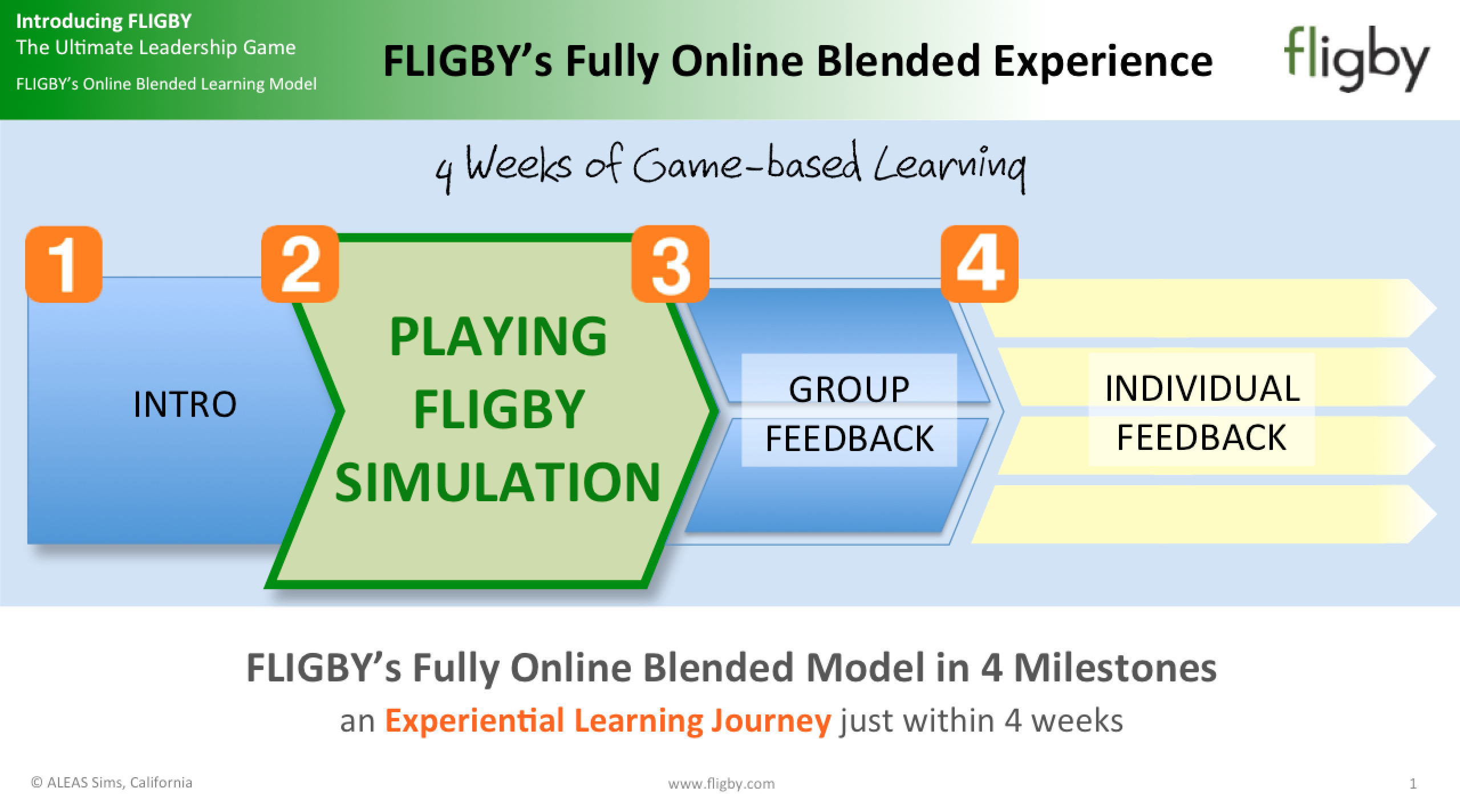
The future of leadership development delivered by virtual business simulation training will become inevitable. Especially since experience-based development is most frequently cited as most impactful, particularly in instances when it:
- most closely resembles a challenging real-life context,
- promotes a start-up level of innovation in a risk-free environment, and
- brings in coaching from leaders and experts.
Several drivers that have recently emerged, primarily due to changes in global circumstances that have limited opportunities for real-life interactions, are strengthening these new trends. From greater demand for self-paced learning and changing media consumption habits to the increasing need for cost efficiency and soft skills development, the modern instructional design must rise to the challenge of providing more immersive and robust training opportunities.
Online Leadership Development: The Rising Star of Self-paced Learning
With greater demands on our time and attention, the preferred learning activity has shifted from the “event-based” to the “progress-based” modalities. Professional development needs quickly evolve toward just-in-time and in-the-flow-of-work approaches to training, where scheduled events are no longer time-efficient or manageable.
Today’s blended learning must offer a flexible learning environment that matches current demands for knowledge acquisition. When compared to traditional forms of training and development, blended learning is expected to offer alternatives that are:
- self-paced versus confined to a schedule,
- personalized versus one-size-fits-all,
- student-centered versus teacher-led,
- focused on collaboration and creativity versus compliance and conformity, and finally
- those that amount to data-driven and competency-based learning.
In the last few months, even the most skeptical HR professionals came to trust e-learning as a viable and reliable alternative to traditional leadership development methods. Many came to recognize that even the most complex topics can be addressed and personal competencies developed with innovative technologies and the right level of support from leaders.
Increase in Demand for Soft Skills Training
In addition to forcing us to move to fully remote, on-demand models of leadership development and compelling us to look for virtual substitutes to experiential learning, the new reality has also brought attention to a greater need for the development of soft skills, which were traditionally not considered appropriate for distance learning.
The recent crisis made us realize that when emotions run high and leaders must address fear and anxiety in their teams, developing soft skills has become more critical than ever. As increased stress levels put our emotional competencies and resilience to an actual test, delivering virtual learning experiences that immerse, connect, and feel real will require even more incredible ingenuity. To answer this call, leadership development professionals are curating experiences focusing on building and refreshing soft critical skills to meet each person’s personal and practical needs, using simulations, micro-courses, web-based training, and virtual sessions.
As we know, digital interaction must be realistic to teach emotional skills effectively. Here is where business simulation games designed as practical management tools for cultivating emotional intelligence and understanding and managing team motivation can effectively teach skills critical to enhanced long-term organizational performance. With their highly realistic digital interactions (also known as “training fields”) supported by personal feedback from tutors via video calls can come to our rescue; they can not only replace the face-to-face and on-site meetings but can help us bring the blended experiential learning to the next level of the challenge created by the fast-evolving trends in how we interact with digital content.
Changing Habits in Media Consumption
Forced into greater levels of media consumption and many suffering from zoom fatigue, our attention span has inevitably shortened. The average period of attention seems not to exceed, even in the case of learning, 45 minutes, which is the average length of a TV series episode like “Game of Thrones” or “Stranger Things.” That’s how our minds are socializing these days. These new, and many would argue improved, habits of interactions with digital media have re-defined the importance of “bite-size” learning.
“Game design isn’t just a technological craft. It’s a twenty-first-century way of thinking and leading.” – Jane McGonigal
Case in point, providers like FLIGBY have re-designed their interactive movie-based online training to accommodate this “bite-size” learning approach. In its original format, the blended learning model allowed for an extensive in-person briefing orientation before playing the game, as well as a full-day debriefing session post the virtual experience, which was a significant component that enabled participants to reflect on their skills and connect their leadership development journey to their real-life context.
But in an entirely online blended approach, this is no longer feasible. The introductory briefing before the gameplay, now down to a 60-minute online group video conference, has been re-designed to manage expectations and focus on the game’s objectives and rules of the game, its branching structure, and reporting functions.
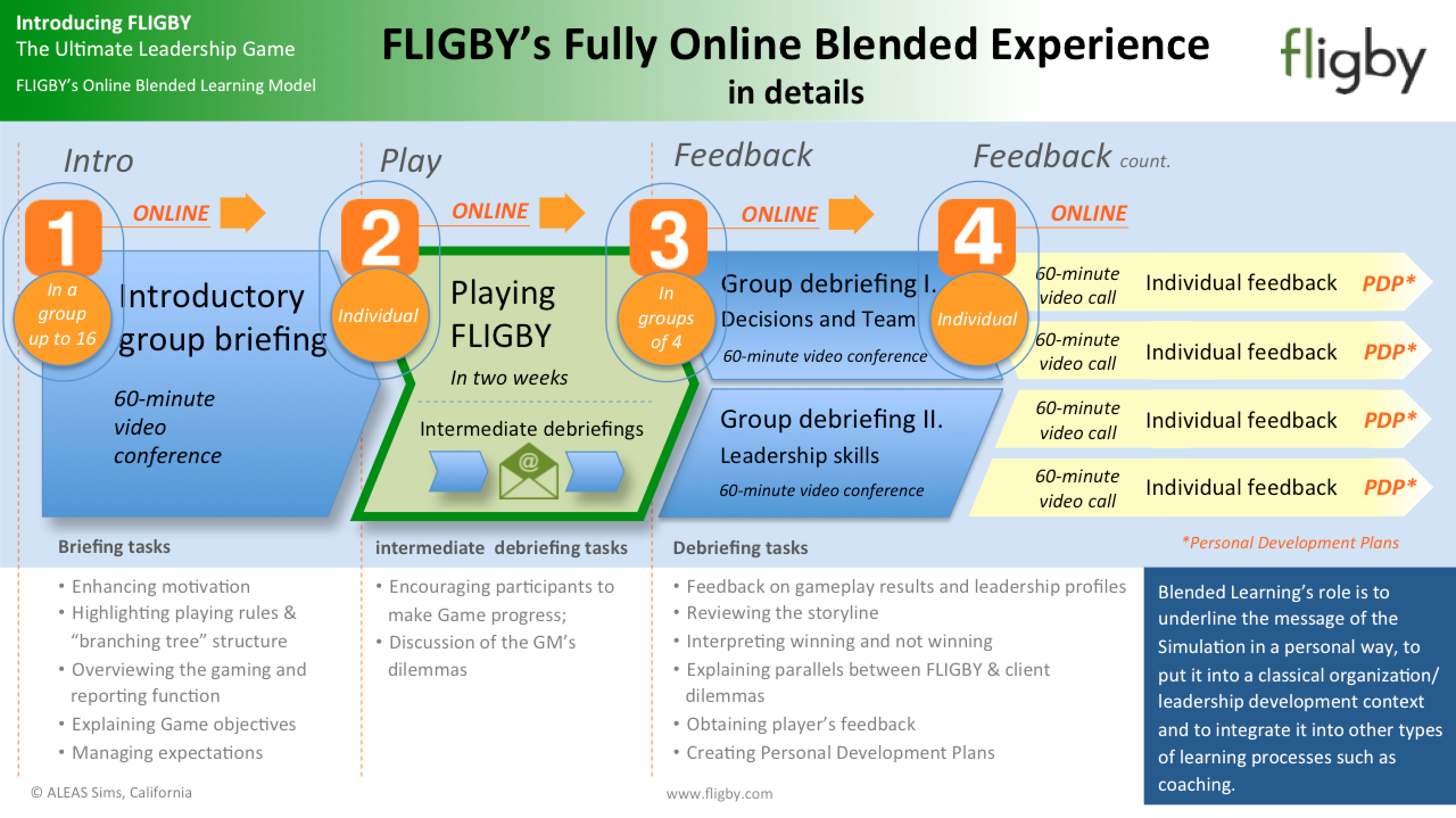
Debriefing sessions after the simulated experience (the game itself includes debriefing tasks to encourage game progress) have been condensed to two 60-minute group video conference sessions. The first debriefing, intended to provide feedback on gameplay results and mainly focused on decisions and teams, comprises reviewing the storyline and interpretations of winning and not winning. The second group debriefing, centered around leadership skills, aims at helping players draw parallels between FLIGBY and their dilemmas. It can connect their leadership profiles to creating personal development plans. To underline the message of the simulation in a unique way and to integrate their learning even further, some may choose to bring that new knowledge into ongoing conversations in the form of individual feedback and coaching sessions.
“The more a job inherently resembles a game—with variety, appropriate and flexible challenges, clear goals, and immediate feedback—the more enjoyable it will be regardless of the worker’s level of development.” – Prof. Mihaly Csikszentmihalyi
As companies track mission-critical content outside their learning management systems and their learning and operations teams go out to form critical partnerships, bringing greater focus and limiting the number of learning-related solutions will be the number one challenge.
Increasing Cost Awareness of Leadership Development
Leadership development has always been somewhat of a luxury. The current economic situation has forced many companies away from in-person leadership development retreats toward more cost-effective solutions. Many ask if leadership development will drop down the priority list as budgets get tighter. Others believe we need great leaders now more than ever.
One solution to this problem is to spend less time and money on training and developing leaders but continue to do it. The secret is to consider it a business process with inputs and outputs.
The price of a well-designed online blended journey is still more reasonable than traditional training. Online solutions like FLIGBY blended experience have no travel costs and can be managed while working, so no time is wasted, and also offer trackable progress and quantifiable results. Some of the most critical outcomes include the ability to test and develop leadership skills in a risk-free simulated environment, followed by a comprehensive game-based profile to build personal development plans and explore parallels between one’s learning and real managerial dilemmas.
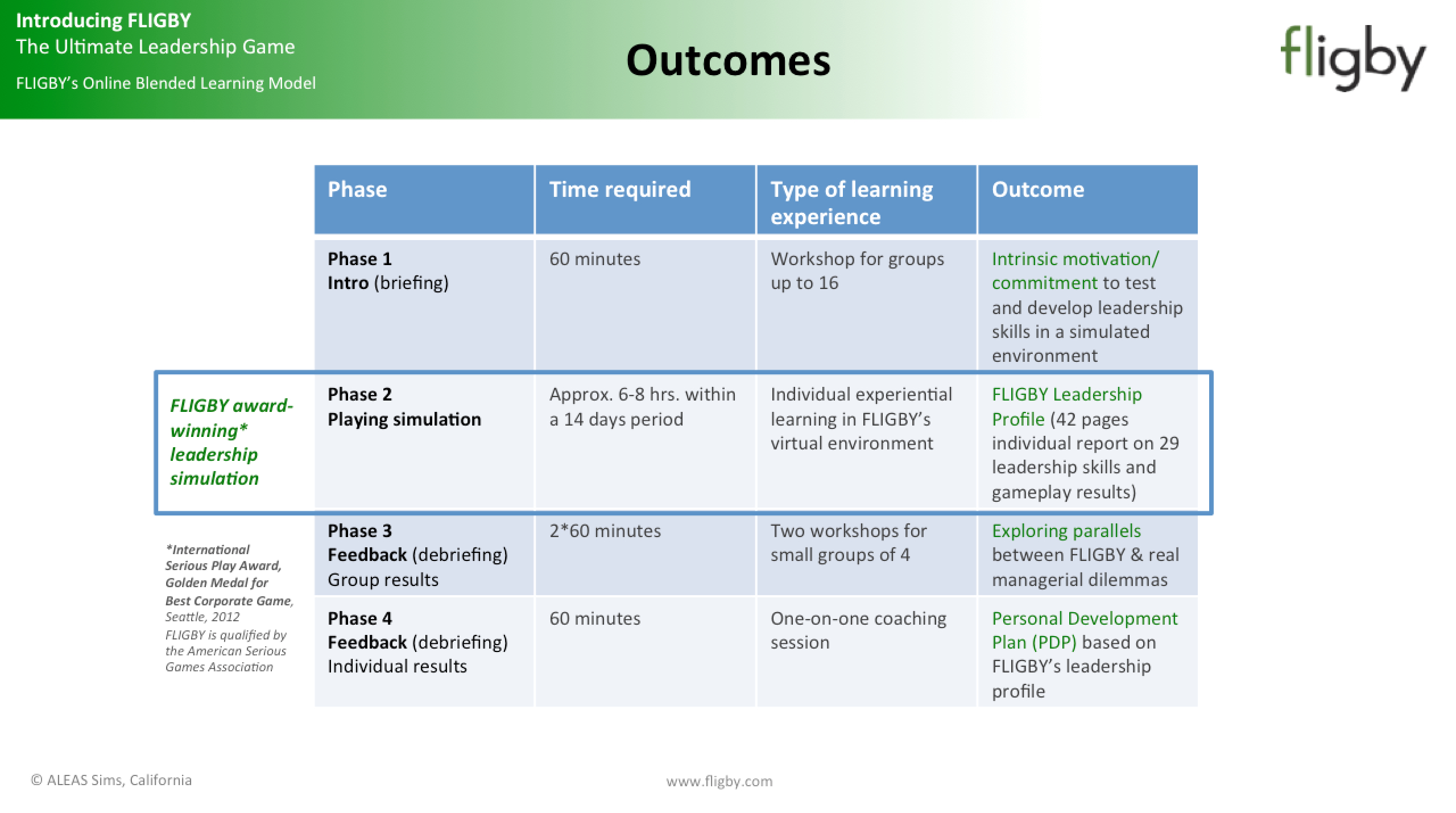
Ideally, a cost-effective, impactful leadership development solution must provide blended experiential learning that focuses on developing essential leadership skills and addresses emotional competencies in an engaging and supported environment for long-term impact. Business simulations like FLIGBY, when offered as a part of an entirely online blended learning model, present a good working solution as they meet all those expectations and show that the business process of leadership development can be done efficiently and economically.
Conclusion
More and more companies will integrate interactive movies and their blended extensions into their skill-development strategies and leadership development programs. Recent history showed us that it is possible to replace effectively and enhance the experiential components of learning in some aspects. Whatever hesitation once existed about virtual learning and digital solutions like serious gaming is quickly evaporating. Workplace learning, primarily driven by leaders’ demands, is undergoing a significant shift in response to the growing needs.
“Of all the virtues we can learn, no trait is more useful, more essential for survival, and more likely to improve the quality of life than the ability to transform adversity into an enjoyable challenge.” – Prof. Mihaly Csikszentmihalyi
Undoubtedly, through these difficult times, we will continue to look for creative ways to enhance human connection and professional development through innovative virtual means. Didactic learning that comprised of dated instructional design built on stale and dense content will be replaced with dynamic blended learning experiences that are personalized, engaging, immersive, and deeply relevant. As we design the future of leadership development, the value of in-person gatherings in the short run is bound to increase. Digital programs will be asked to deliver more excellent results, and behavioral change organizations must enable every leader to be their best.
References
- Csikszentmihalyi, M. (2004). Good Business: Leadership, Flow, and the Making of Meaning. New York, NY: Penguin.
- Marer, P., Buzady, Z. & Vecsey, Z. (2017). Missing Link Discovered. ALEAS Sims Hungary-USA (Publisher)
- McCauley, C. D., DeRue, D. S., Yost, P. R., & Taylor, S. (2014). Experience-Driven Leader Development: Models, Tools, Best Practices, and Advice for On-The-Job Development. San Francisco, CA: Wiley.
- McGonigal, J. (2011). Reality is Broken: Why Games Make US Better and How They Can Change the World. New York, NY: Penguin Books.
- Jefferson, A., Wick, C. W., & Pollock, R. V. H. (2006). The Six Disciplines of Breakthrough Learning: How to Turn Training and Development Into Business Results. Hoboken, NJ: John Wiley & Sons. Inc.
- Tucker, C. R. (2019). Power Up Blended Learning: A Professional Learning Infrastructure to Support Sustainable Change. Thousand Oaks, CA: Corwin.
- Tucker, C. R., Wycoff, T., & Green, J. T. (2016). Blended Learning in Action: A Practical Guide Toward Sustainable Change. Thousand Oaks, CA: Corwin.


